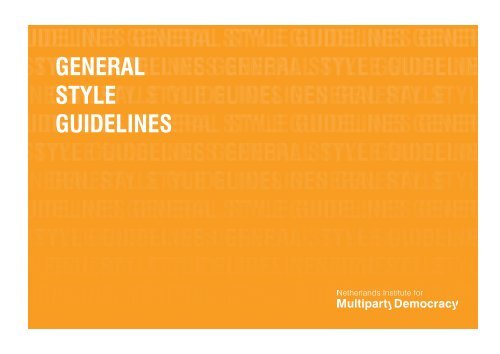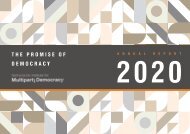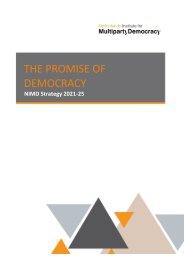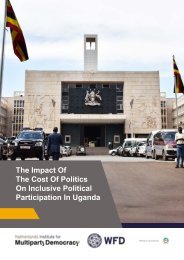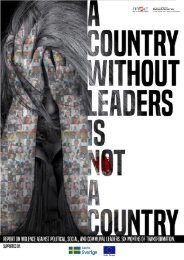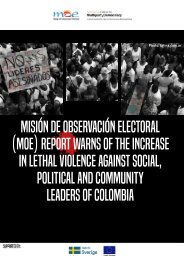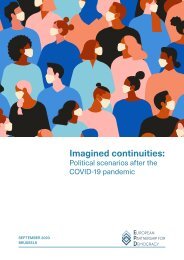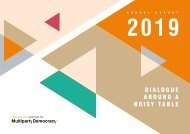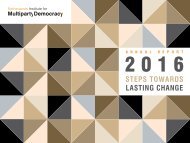NIMD Style Guidelines
You also want an ePaper? Increase the reach of your titles
YUMPU automatically turns print PDFs into web optimized ePapers that Google loves.
GENERAL GENERAL STYLE STYLE GUIDELINES GENERAL GENERAL STYLE STYLE<br />
GUIDELINES GENERAL STYLE GUIDELINES GENER-<br />
AL L STYLE GENERAL GUIDELINES GENERAL STYLE GUIDELINES<br />
GENERAL GENERAL STYLE STYLE STYLE GUIDELINES GENERAL GENERAL STYLE STYLE<br />
GUIDELINES<br />
GENERAL STYLE GUIDELINES GENER-<br />
AL L STYLE GUIDELINES GENERAL STYLE GUIDELINES<br />
GENERAL GENERAL STYLE STYLE GUIDELINES GENERAL GENERAL STYLE STYLE<br />
GUIDELINES GENERAL STYLE GUIDELINES GENER-<br />
AL L STYLE GUIDELINES GENERAL STYLE GUIDELINES<br />
GENERAL GENERAL STYLE STYLE GUIDELINES GENERAL GENERAL STYLE STYLE<br />
GUIDELINES GENERAL STYLE GUIDELINES GENER-<br />
AL L STYLE GUIDELINES GENERAL STYLE GUIDELINES
INTRODUCTION<br />
This document contains guidelines on how to apply the visual identity of <strong>NIMD</strong>.<br />
It is divided into three sections:<br />
• a section with the general style guidelines;<br />
• a writing guide;<br />
• an annex with technical specifications.<br />
The first and second section are designed for <strong>NIMD</strong> staff and implementing partners.<br />
They can use this document to brief their communication agencies and approve and<br />
monitor communication activities in their countries.<br />
The annex is specifically for the designers and communication agencies. It provides all the<br />
technical details on the use of <strong>NIMD</strong>’s style elements.<br />
WHEN A VISUAL<br />
IDENTITY IS PRESENTED<br />
CONSISTENTLY, IT<br />
CREATES A POSITIVE AND<br />
LASTING IMPRESSION OF<br />
THE ORGANIZATION.<br />
All style elements can be downloaded from the <strong>Style</strong> Guide website:<br />
www.nimd.org/<strong>Style</strong>Guide<br />
This <strong>Style</strong> Guide ensures that everyone within <strong>NIMD</strong> – from <strong>NIMD</strong> Headquarters (HQ) in<br />
The Hague to country offices and implementing partner organizations – represents <strong>NIMD</strong><br />
in the same way.<br />
For questions about the <strong>Style</strong> Guide or specific style elements you can contact the<br />
Communications Department at <strong>NIMD</strong> Headquarters by sending an email<br />
to: info@nimd.org<br />
Important note:<br />
All external communication professionals need prior approval from their <strong>NIMD</strong><br />
contact before using this manual.<br />
2
CONTENTS<br />
<strong>Style</strong> Guide<br />
04<br />
1. The <strong>NIMD</strong> logo<br />
2. The <strong>NIMD</strong> slogan<br />
3. The <strong>NIMD</strong> colour system<br />
4. Photography<br />
5. Website and social media<br />
6. Use of fonts<br />
7. Miscellaneous<br />
05<br />
10<br />
11<br />
13<br />
14<br />
16<br />
17<br />
Writing guide<br />
19<br />
Annex technical specifications<br />
22<br />
3
ENERAL GENERAL STYLE STYLE GUIDELINES GENERAL GENERAL STYLE STYLE<br />
GUIDELINES GENERAL STYLE GUIDELINES GENER-<br />
L L STYLE STYLE GUIDELINES GENERAL STYLE GUIDELINES<br />
ENERAL GENERAL GUIDE STYLE STYLE GUIDELINES GENERAL GENERAL STYLE STYLE<br />
GUIDELINES GENERAL STYLE GUIDELINES GENER-<br />
L L STYLE GUIDELINES GENERAL STYLE GUIDELINES<br />
ENERAL GENERAL STYLE STYLE GUIDELINES GENERAL GENERAL STYLE STYLE<br />
GUIDELINES GENERAL STYLE GUIDELINES GENER-<br />
L L STYLE GUIDELINES GENERAL STYLE GUIDELINES<br />
ENERAL GENERAL STYLE STYLE GUIDELINES GENERAL GENERAL STYLE STYLE<br />
GUIDELINES GENERAL STYLE GUIDELINES GENER-<br />
L L STYLE GUIDELINES GENERAL STYLE GUIDELINES<br />
4
1. THE <strong>NIMD</strong> LOGO<br />
This is the <strong>NIMD</strong> logo.<br />
Dutch (Royal) Orange<br />
Its two distinguishing features are the use of the colour orange for<br />
‘Netherlands’ and the orange leaf in the second line (image 1).<br />
1.<br />
Symbolizing growth<br />
DIFFERENT LANGUAGES<br />
The <strong>NIMD</strong> logo is available with a translation for use in other languages: French, Spanish,<br />
Dutch and Arabic (image 2).<br />
2.<br />
5
LOGO POSITIONING BY COUNTRY OFFICES<br />
The logo should always be positioned in the top right (image 1) or top left (image 2) of the<br />
page. The preferred position is the top left.<br />
LOGO POSITIONING BY IMPLEMENTING PARTNERS<br />
When communicating about <strong>NIMD</strong> programme activities, partner organizations are<br />
requested to use the <strong>NIMD</strong> logo in combination with their own logo where possible and<br />
appropriate. In this case, it is up to the designer to position the logo.<br />
1.<br />
2.<br />
In case of doubts, please consult the <strong>NIMD</strong> Communications Department.<br />
EXTRA LOGO OPTION<br />
When <strong>NIMD</strong>’s regular logo does not work, you can use the extra logo option (image 3).<br />
Remember: this logo is for exceptions only. Use it only if:<br />
• The <strong>NIMD</strong> logo is presented in combination with other logos and there is not much<br />
space to present the logos and<br />
• The combination and lack of space affects the readability of our logo.<br />
3.<br />
Important note:<br />
When deciding whether to use the extra logo, you will have to judge every<br />
communication product individually. As a rule of thumb, only use this option if the<br />
<strong>NIMD</strong> logo is smaller than 30% of the original size (image 4).<br />
4.<br />
6
USING THE LOGO AGAINST DIFFERENT BACKGROUNDS<br />
The <strong>NIMD</strong> logo can be used against different backgrounds:<br />
If the background is white or light, we use the regular logo (image 1).<br />
1.<br />
If the background is coloured, you can use the inversed version of the logo.<br />
The preferred combination is orange and white (image 2).<br />
2.<br />
If the background is orange, this logo is also available in white and black (image 3).<br />
3.<br />
If the background is complex, you can use the complete white logo (image 4).<br />
4.<br />
WHAT TO AVOID<br />
When placing the logo on a coloured background, please use the ‘transparent logo’,<br />
which is available for download on the <strong>Style</strong> Guide website. This logo has a transparent<br />
background, meaning that it will sit directly on your page, rather than appearing with a<br />
white box around it (image 5).<br />
5.<br />
7
INCORRECT USE OF LOGO<br />
It is not permitted to add or change elements in the logo.<br />
• No adding elements to the logo (image 1)<br />
1.<br />
• No reshaping the logo (image 2)<br />
• No re-sizing one line of the logo (image 3)<br />
2.<br />
• No outlining the logo (image 4)<br />
2.<br />
3.<br />
• No re-colouring the logo (image 5)<br />
• No adding drop-shadow (image 6)<br />
4.<br />
• No use of abbreviated logo (image 7)<br />
5.<br />
Important note:<br />
As of 2016, it is also no longer permitted to use the abbreviated logo in any <strong>NIMD</strong><br />
materials, including both online (website, social media) and offline (documents,<br />
publications) communications.<br />
6.<br />
7.<br />
8
SUPPORTING VISUAL<br />
The <strong>NIMD</strong> leaf can be used to support the <strong>NIMD</strong> logo in large Word documents or<br />
PowerPoint presentations.<br />
Never use the image standalone: Always use the official <strong>NIMD</strong> logo on the first page of<br />
your document of presentation (image 1), followed by the leaf on the other pages (if<br />
desired). When used, the leaf should always be positioned in the top right-hand corner<br />
(image 2).<br />
The size of the leaf should not distract from the content. Never place the official logo and<br />
the leaf next to each other.<br />
Important note:<br />
The orange leaf does not replace the <strong>NIMD</strong> logo.<br />
1. 2.<br />
9
2. THE <strong>NIMD</strong> SLOGAN<br />
<strong>NIMD</strong>’s slogan is ‘Democracy starts with dialogue.’<br />
The slogan should always be presented in 1 or 3 lines. It should never be written across 2<br />
lines, as this would be too similar to the <strong>NIMD</strong> logo.<br />
Democracy<br />
starts with<br />
When using the slogan:<br />
• Always use the slogan in combination with the logo, never standalone. It is not a<br />
substitute for the logo.<br />
• Never place the slogan directly under the logo. We recommend presenting the official<br />
logo on the cover or first page of a publication or presentation, and having the slogan<br />
on the last page or slide.<br />
• You are not obliged to use the slogan in your communications. Use it only if it fits in<br />
your design and if you feel it adds to, or underlines your key message.<br />
dialogue.<br />
The slogan is available in black and orange and in the different <strong>NIMD</strong> languages (Dutch,<br />
French, Spanish and Arabic). These can be downloaded from <strong>Style</strong> Guide website:<br />
www.nimd.org/<strong>Style</strong>Guide<br />
10
3. THE <strong>NIMD</strong> COLOUR SYSTEM<br />
<strong>NIMD</strong>’s main colours are orange, black and grey.<br />
Orange symbolizes and emphasises <strong>NIMD</strong>’s Dutch background.<br />
CMYK 2 38 98 0<br />
RGB 249 157 54<br />
Pantone C 1375 C<br />
CMYK 64 56 53 29<br />
RGB 87 87 89<br />
Pantone SC 425 C<br />
Country offices should use the <strong>NIMD</strong> colour system as much as possible in their<br />
communications. This provides consistency and strengthens the <strong>NIMD</strong> brand.<br />
Implementing partners are kindly requested to use their own organization’s colour system<br />
and branding. In the case of communicating <strong>NIMD</strong> programme activities, it is sufficient to<br />
use the <strong>NIMD</strong> logo – the other elements of the style are reserved for <strong>NIMD</strong> and its country<br />
offices.<br />
CMYK 75 68 67 90<br />
RGB 0 0 0<br />
Pantone SC Black 6 C<br />
<strong>NIMD</strong> SUPPORTING COLOURS<br />
These are our supporting colours. They bring an extra dimension to the design and can be<br />
used by <strong>NIMD</strong> country offices for infographics, tables, and as background colours for<br />
pages, etc.<br />
Use of the supporting colours is recommended. Using only black can be a bit too ‘cold’.<br />
Please be careful when using the colour orange for (larger) text boxes and tables because it<br />
is very bright. It can diminish the readability of your text, so use a higher transparency.<br />
On the right, you see the various supporting colours of <strong>NIMD</strong>.<br />
CMYK 6 3 0 23<br />
RGB 186 192 197<br />
Pantone SC 428 C<br />
CMYK 0 6 15 7<br />
RGB 236 221 201<br />
Pantone PNC 9184 C<br />
CMYK 8 11 18 0<br />
RGB 232 220 204<br />
Pantone PNC 9153 C<br />
CMYK 0 13 33 20<br />
RGB 205 178 137<br />
Pantone SU 7502<br />
CMYK 0 13 32 36<br />
RGB 164 143 111<br />
Pantone SC 2325 C<br />
CMYK 0 19 50 53<br />
RGB 120 97 60<br />
Pantone 1375<br />
Important note:<br />
For use of different shades of the colours, please refer to the ‘Technical<br />
specifications’ in the Annex, p.22.<br />
CMYK 0 10 25 19<br />
RGB 206 185 154<br />
Pantone PNC 9163 C<br />
11
12<br />
EXAMPLE OF USE OF THE <strong>NIMD</strong> COLOURS
4. PHOTOGRAPHY USEFUL PHOTO DATABASES<br />
<strong>NIMD</strong> makes use of photography to help to underline our communication messages.<br />
We use a number of criteria when selecting photos:<br />
1. FLICKR<br />
https://www.flickr.com/<br />
( Use “Creative Commons” license )<br />
• Not activist. <strong>NIMD</strong> is not an activist organization. We work with parliamentary<br />
political parties. Instead, show photos that are relevant to <strong>NIMD</strong>: elections, meetings,<br />
rallies.<br />
• No political symbols in the photos. No peace symbols, ‘V’ signs, or fists. In various<br />
countries, symbols mean different things. The photos can show expressions on<br />
people’s faces, situations, etc., but no symbols or aggressive behaviour.<br />
• No aid campaign/development sector look and feel. We want to show powerful<br />
people, happy people, and positive environments.<br />
• No still life. Images should depict people not objects.<br />
• Preferably no staged photos. Show people in their real environment and in real<br />
situations.<br />
2. WORLD BANK PHOTO COLLECTION ON FLICKR<br />
https://www.flickr.com/people/worldbank/<br />
3. EUROPEAN PARLIAMENT MEDIA NETWORK<br />
http://bit.ly/2k9P5oM<br />
4. UN PHOTO<br />
http://www.unmultimedia.org/photo/<br />
( Registration required )<br />
Important note:<br />
If you are not sure whether the photo is appropriate, please contact the<br />
Communications Department in The Hague for further guidance.<br />
<strong>NIMD</strong> CORPORATE STYLE PHOTOGRAPHY<br />
Based on these guidelines <strong>NIMD</strong> has developed a specific corporate style which consists of:<br />
• Greyscale effects on all photos<br />
• Use of the <strong>NIMD</strong> orange, grey and white text and graphics<br />
This style is reserved for <strong>NIMD</strong> and its country offices.<br />
13
5. WEBSITE AND SOCIAL MEDIA<br />
WEBSITE INFORMATION FOR COUNTRY OFFICES<br />
The <strong>NIMD</strong> country office websites are based on the corporate site ensuring a consistent look<br />
and feel across <strong>NIMD</strong>’s online communications.<br />
A template of the <strong>NIMD</strong> site is provided to all <strong>NIMD</strong> country offices. Please contact the <strong>NIMD</strong><br />
Communications Department for more details or access to the template.<br />
WEBSITE INFORMATION FOR IMPLEMENTING PARTNERS<br />
<strong>NIMD</strong>’s implementing partners have their own websites.<br />
Partners are requested to mention their collaboration with <strong>NIMD</strong> on their websites where<br />
appropriate. When making reference to <strong>NIMD</strong>, please keep the following in mind:<br />
• present the full organization name (Netherlands Institute for Multiparty Democracy)<br />
• provide a link to <strong>NIMD</strong>’s corporate website (nimd.org)<br />
• include a standard explanatory paragraph, e.g. The Netherlands Institute for Multiparty<br />
Democracy (<strong>NIMD</strong>) supports democratization and political parties in developing<br />
democracies by encouraging interparty dialogue.<br />
14
v<br />
SOCIAL MEDIA<br />
<strong>NIMD</strong> encourages the use of social media by both the country offices and implementing<br />
partners. For our country offices, please follow these instructions:<br />
• <strong>NIMD</strong>’s profile photo should be the leaf image.<br />
• The cover photo should be <strong>NIMD</strong>’s logo with translation in your country’s language where<br />
available.<br />
• The following text should always be used on <strong>NIMD</strong>’s bio/introduction pages on social<br />
media:<br />
The Netherlands Institute for Multiparty Democracy (<strong>NIMD</strong>) is a democracy assistance<br />
organization that supports political parties in developing democracies.<br />
There are no specific guidelines for the implementing partners, as they will communicate via<br />
their own channels using their own organization name.<br />
15
6. USE OF FONTS<br />
SWISS 721<br />
<strong>NIMD</strong>’s official font for online and offline publications is Swiss 721. We use the version<br />
made by Bitstream in the following weights: Thin, light, roman, medium, bold, condensed,<br />
bold condensed.<br />
Aa<br />
Important note:<br />
Swiss 721 is not a standard font in Word. It can be downloaded from our <strong>Style</strong> Guide<br />
website. Designers and printers are not permitted to download and use the font for<br />
other customers or other purposes.<br />
ABCDEFGHIJKLMNOPQRSTUVWXYZ<br />
abcdefghijklmnopqrstuvwxyz<br />
0123456789<br />
CALIBRI<br />
When working in Word, we use Calibri.<br />
• Calibri 11 for normal text<br />
• Calibri 16, bold, for chapter titles<br />
• Calibri 12, bold, for paragraph titles, captions, and tables<br />
For more on Word documents see the Writing Guide (p.19).<br />
Aa<br />
ABCDEFGHIJKLMNOPQRSTUVWXYZ<br />
abcdefghijklmnopqrstuvwxyz<br />
0123456789<br />
16<br />
16
C<br />
M<br />
Y<br />
CM<br />
MY<br />
CY<br />
CMY<br />
K<br />
<strong>NIMD</strong>_Banner2015_pms1375_oranje_def.pdf 1 04-03-15 11:32<br />
7. MISCELLANEOUS<br />
BUSINESS CARDS<br />
In general, business cards for the country offices are printed in the Netherlands.<br />
The offices can also choose to use the InDesign template for printing in their own<br />
countries. The template is available on the website.<br />
Important note:<br />
The same set of details should always be presented in the ‘contact information’<br />
section of the business cards.<br />
Egbert Pos<br />
Senior Programme Manager Africa<br />
M +31 6 11 47 98 04<br />
T +31 70 311 49 93<br />
egbertpos@nimd.org<br />
skype: egbertpos<br />
Passage 31<br />
2511 AB The Hague<br />
The Netherlands<br />
www.nimd.org<br />
Democracy<br />
starts with<br />
dialogue.<br />
BANNERS<br />
This is the standard <strong>NIMD</strong> banner. The criteria for <strong>NIMD</strong> banners are:<br />
• Background: <strong>NIMD</strong> orange<br />
• Simple design: no photos or illustrations, only the logo (+ slogan)<br />
In case of a joint banner with a partner, <strong>NIMD</strong> obviously cannot claim an orange<br />
background. Here it is important to make sure that <strong>NIMD</strong>’s logo is<br />
incorporated correctly in the design (See the guidelines for logo use, p.5).<br />
17
GIVEAWAYS<br />
Official giveaways must always contain the <strong>NIMD</strong> logo on the cover itself (image 1). We<br />
only use the official logo (with the orange element) for giveaways. Never use the leaf or<br />
the extra logo option.<br />
VIDEOS<br />
In an official <strong>NIMD</strong> video, always start and/or end the video with <strong>NIMD</strong>’s logo.<br />
In the case of partner organizations, please mention <strong>NIMD</strong> in videos relating to programme<br />
activities.<br />
MANDELA VISUAL<br />
1.<br />
As of 2015, <strong>NIMD</strong>’s Mandela visual (image 2) is no longer in use. It should not be used in<br />
any official <strong>NIMD</strong> communications.<br />
Do not use this visual<br />
“ If you want to make peace with your enemy,<br />
you have to work with your enemy. Then he<br />
becomes your partner”<br />
www.nimd.org<br />
2.<br />
18
WRITING GUIDE GUIDE WRITING GUIDE GUIDE WRITING GUIDE GUIDE WRW<br />
GUIDE GUIDE WRITING GUIDE GUIDE WRITING GUIDE GUIDE WRITING GUG<br />
WRITING GUIDE GUIDE WRITING GUIDE GUIDE WRITING GUIDE GUIDE WRW<br />
GUIDE GUIDE GUIDE<br />
WRITING GUIDE GUIDE WRITING GUIDE GUIDE WRITING GUG<br />
WRITING GUIDE GUIDE WRITING GUIDE GUIDE WRITING GUIDE GUIDE WRW<br />
GUIDE GUIDE WRITING GUIDE GUIDE WRITING GUIDE GUIDE WRITING GUG<br />
WRITING GUIDE GUIDE WRITING GUIDE GUIDE WRITING GUIDE GUIDE WRW<br />
GUIDE GUIDE WRITING GUIDE GUIDE WRITING GUIDE GUIDE WRITING GUG<br />
WRITING GUIDE GUIDE WRITING GUIDE GUIDE WRITING GUIDE GUIDE WRW<br />
GUIDE GUIDE WRITING GUIDE GUIDE WRITING GUIDE GUIDE WRITING GUG<br />
WRITING GUIDE GUIDE WRITING GUIDE GUIDE WRITING GUIDE GUIDE WRW<br />
GUIDE GUIDE WRITING GUIDE GUIDE WRITING GUIDE GUIDE<br />
19
WRITING GUIDE<br />
In <strong>NIMD</strong>’s efforts to further enhance its professionalism, the use of proper and coherent English is<br />
indispensable.<br />
STYLE CHOICES<br />
Drawing up Word documents:<br />
• Use Calibri 11 for normal text<br />
• Use Calibri 16, bold, for chapter titles<br />
• Use Calibri 12, bold, for paragraph titles, captions, and tables<br />
Do not use indentation at the beginning of a new paragraph. Avoid word division at the end of the<br />
line. Make sure that each new subject is introduced in a new paragraph containing a topic sentence<br />
(a sentence that introduces the topic of the paragraph).<br />
Use a double space between paragraphs.<br />
SPELLING AND GRAMMAR<br />
ABBREVIATIONS<br />
Avoid abbreviations, especially such expressions as e.g., etc., cf., and i.e. Where abbreviations such<br />
as IEA, Fubodem, LIPI, PKS, PPP must be used, spell out these abbreviations when used the first time,<br />
with the abbreviation between parentheses. For instance:<br />
Centre Malien pour le dialogue inter-partis et la democratie (CMDID) was founded in 2008.<br />
Where it may be unclear what a phrase means because it is in a language other than English, a<br />
translation may be added. For instance:<br />
Centre Malien pour le dialogue inter-partis et la democratie (Centre for Interparty Dialogue and<br />
Democracy Mali – CMDID) was founded in 2008.<br />
Abbreviations must be capitalized. If they can be made plural, this should be done by adding a lowercase<br />
‘s’ without an apostrophe. For instance: NGOs rather than NGO’s.<br />
Follow the spelling of the Oxford advanced learner’s dictionary of English (for instance: analyse,<br />
honour, colour, realize, organize, programme, centre).<br />
Words in a title or a heading should be written in lower case, except for the first word and any proper<br />
nouns such as names of persons, organizations, or countries. For instance: The Oxford advanced<br />
learner’s dictionary of English.<br />
DATES<br />
Write all dates in cardinal numbers with the day before the month. For instance: 21 December.<br />
Do not write 21st December or December 21.<br />
The names of months and days are capitalized. For instance: Tuesday 31 August 2005 (not: tuesday<br />
31-08-05).<br />
QUOTATIONS<br />
When quoting from another text, use single quotation marks and put square brackets around any<br />
additions or deletions not appearing in the original, as shown in the examples below. A quotation<br />
within a quotation is set off by double quotation marks.<br />
Original: ‘Misquoting an author is considered a serious offence by many people.’<br />
• ‘Misquoting [a source] is […] a serious offence’<br />
• While referring to the senior policy officer, he argued that ‘deadlines are to be considered holy<br />
and “misquoting an author is considered a serious offence”.’<br />
20
WRITING GUIDE<br />
SPELLING OF NAMES<br />
ILLUSTRATIONS<br />
Original spellings should be retained for personal names, even though these spellings may be<br />
outdated today. Similarly, names of newspapers, periodicals, organizations, official titles, and the<br />
like, are to be given in their contemporary spellings (with English translations in parentheses, where<br />
necessary).<br />
Geographical names are to be given in their modern English spelling. For instance: Suriname rather<br />
than Surinam.<br />
Geographical terms commonly accepted as proper names are capitalized. Other descriptive or<br />
identifying geographical terms that either are not taken to apply to one geographical entity only or<br />
have not become commonly regarded as proper names for these entities are not capitalized. These<br />
terms are not capitalized when they simply denote direction or compass points. For instance:<br />
• Central America, Central American; central Europe<br />
• North Africa; East (West) Africa; northern, eastern, southern, central Africa<br />
• Southeast Asia; southeastern Asia; central Asia<br />
• The West; western Europe<br />
FOREIGN TERMS<br />
Foreign terms lacking widely accepted English equivalents should be supplied with an English<br />
translation in brackets the first time they appear.<br />
Avoid adding an ‘s’ to form the plural of nouns in languages such as Indonesian and other languages<br />
that do not have the plural ‘s’. The context of the word should make it sufficiently clear whether it is<br />
meant in a plural or singular sense.<br />
Spell all foreign words correctly. Pay attention to accent marks (for instance: è, é, ä, ö).<br />
Prepare maps, graphs, and figures carefully. Submit each illustration on a separate page, giving the<br />
caption, stating sources, and indicating clearly where it is to appear in the text.<br />
The author is responsible for making the necessary arrangements for permission to reproduce<br />
copyrighted material.<br />
NUMBERS, FIGURES, CURRENCIES<br />
Use the comma (,) instead of a full stop (.) in numbers containing more than four digits: 10,000.<br />
Be aware of and consistent in your use of currency symbols. These symbols precede the amount<br />
of money. Use the euro sign (€); do not use the words euro or euros. Other currencies should be<br />
treated similarly. If you have to refer to American dollars, please use US$.<br />
Leave a space between the currency sign and the amount. For instance: € 10,000 rather than<br />
€10,000 (or even 10.000 euros).<br />
Round currency figures off to the nearest euro (or other currency). For instance: € 10,234.59 must be<br />
written as € 10,235.<br />
All numbers below 101 are written in full when used in a text (one, two, three…one hundred) unless<br />
the sentence contains a combination. For instance:<br />
• About fifty delegates attended the meeting.<br />
• The 50 delegates represented 125 countries.<br />
21
ANNEX TECHNICAL SPECIFICATIONS ANNEX TECH<br />
CAL SPECIFICATIONS ANNEX TECHNICAL SPECIFIC<br />
ANNEX TIONS ANNEX TECHNICAL SPECIFICATIONS ANN<br />
TECHNICAL<br />
SPECIFICATIONS ANNEX TECHNICAL SPE<br />
SPECIFICATIONS<br />
ANNEX TECHNICAL SPECIFICATIONS ANN<br />
TECHNICAL SPECIFICATIONS ANNEX TECHNICAL SPE<br />
FICATIONS ANNEX TECHNICAL SPECIFICATIONS ANN<br />
TECHNICAL SPECIFICATIONS ANNEX TECHNICAL SPE<br />
FICATIONS ANNEX TECHNICAL SPECIFICATIONS ANN<br />
TECHNICAL SPECIFICATIONS ANNEX TECHNICAL SPE<br />
FICATIONS ANNEX TECHNICAL SPECIFICATIONS ANN<br />
TECHNICAL SPECIFICATIONS ANNEX TECHNICAL SPE<br />
22
ANNEX TECHNICAL SPECIFICATIONS<br />
LOGO FILE TYPE<br />
PAPER USE<br />
The <strong>NIMD</strong> logo is available in different technical formats. These can be downloaded from <strong>Style</strong> Guide<br />
website: www.nimd.org/<strong>Style</strong>Guide<br />
<strong>NIMD</strong> uses wood-free uncoated offset paper for printing brochures and other publications.<br />
• In Word documents and other templates, use the jpg logo file.<br />
• For (offset) printing, designers and printers need a high quality logo file: an eps-file. These are<br />
vector files which can’t be opened on a regular computer. <strong>NIMD</strong> has two eps-files, one with pms<br />
and one with the fullcolour system. If your printer does not request a specific type, then send<br />
the printer both eps-files.<br />
• For websites, there is a special web logo variant, which you can download from the <strong>Style</strong> Guide<br />
website.<br />
Important note:<br />
<strong>NIMD</strong> uses off-white paper for brochures and other publications. Do not use pure<br />
white paper.<br />
Specs for brochures, business cards and other stationary:<br />
Brochures/publications in offset printing<br />
Cover: Arctic Volume White 250 – 300 g/m²<br />
Pages: Munken Lynx 120 – 130 g/m²<br />
Business cards<br />
Offset printed on 250 g/m²<br />
Multibusiness Extra White<br />
Other stationery (envelopes, letterheads, etc.) items are also printed on variations of Multibusiness<br />
Extra White.<br />
Digital colour printing<br />
Cover: Go Matt 300 g/m²<br />
Pages: Go Matt 170 g/m²<br />
23
ANNEX TECHNICAL SPECIFICATIONS<br />
THE <strong>NIMD</strong> COLOUR SYSTEM<br />
The RGB colour system is used for online communications.<br />
CMYK 0 50 100 0<br />
RGB 238 130 39<br />
Pantone C 1375 C<br />
CMYK 75 68 67 90<br />
RGB 0 0 0<br />
Pantone SC Black 6 C<br />
Use CMYK and Pantone when you have colour photos in a design that needs to be printed<br />
(e.g. a magazine).<br />
Be careful when using the colour orange for (larger) text boxes and tables because it is<br />
very bright. It can diminish the readability of your text, so use lighter percentages.<br />
CMYK 64 56 53 29<br />
RGB 87 87 89<br />
Pantone SC 425 C<br />
24
CMYK 6 3 0 23<br />
RGB 186 192 197<br />
Pantone SC 428 C<br />
CMYK 27 18 17 10<br />
RGB 170 176 180<br />
Pantone SU 428U U<br />
CMYK 0 9 24 33<br />
RGB 170 155 129<br />
Pantone SU 2324 U<br />
CMYK 0 8 24 40<br />
RGB 153 140 116<br />
Pantone SC 2325 C<br />
CMYK 7 3 0 35<br />
RGB 155 161 166<br />
Pantone SC 422 C<br />
CMYK 7 3 0 41<br />
RGB 139 146 150<br />
Pantone SC 877 C<br />
CMYK 0 14 34 19<br />
RGB 206 178 136<br />
Pantone SU 7502 U<br />
CMYK 0 13 34 27<br />
RGB 187 162 124<br />
Pantone SC 2324 C<br />
CMYK 0 9 17 0<br />
RGB 255 231 212<br />
Pantone PNC 9200 C<br />
CMYK 0 9 16 6<br />
RGB 240 218 201<br />
Pantone SC 2309 C<br />
CMYK 0 13 33 33<br />
RGB 170 148 114<br />
Pantone SC 2325 C<br />
CMYK 0 12 33 40<br />
RGB 153 134 103<br />
Pantone SC 2325 C<br />
CMYK 0 9 16 10<br />
RGB 230 209 193<br />
Pantone SC 482 C<br />
CMYK 0 9 16 14<br />
RGB 219 200 185<br />
Pantone SC 482 C<br />
CMYK 0 9 17 0<br />
RGB 164 143 111<br />
Pantone SC 2325 C<br />
CMYK 0 12 32 39<br />
RGB 156 137 106<br />
Pantone SC 2325 C<br />
CMYK 0 6 15 8<br />
RGB 234 220 200<br />
Pantone PNC 9162 C<br />
CMYK 0 6 14 16<br />
RGB 213 201 183<br />
Pantone 7534 C<br />
CMYK 0 12 32 47<br />
RGB 135 119 92<br />
Pantone SC 2326 C<br />
CMYK 0 12 32 53<br />
RGB 121 107 82<br />
Pantone SC 7561 C<br />
CMYK 0 6 13 24<br />
RGB 194 183 168<br />
Pantone SC 7528 C<br />
CMYK 0 5 13 32<br />
RGB 174 165 152<br />
Pantone SC 401 C<br />
CMYK 0 18 50 53<br />
RGB 120 98 60<br />
Pantone SC 7769 C<br />
CMYK 0 18 51 58<br />
RGB 106 87 52<br />
Pantone SC 7561 C<br />
CMYK 0 10 25 20<br />
RGB 205 185 154<br />
Pantone PNC 9163 C<br />
CMYK 0 9 25 27<br />
RGB 186 169 140<br />
Pantone SC 2324 C<br />
CMYK 0 18 53 64<br />
RGB 93 76 44<br />
Pantone SC 450 C<br />
CMYK 0 19 55 69<br />
RGB 80 65 36<br />
Pantone SC 449 C<br />
25
26


